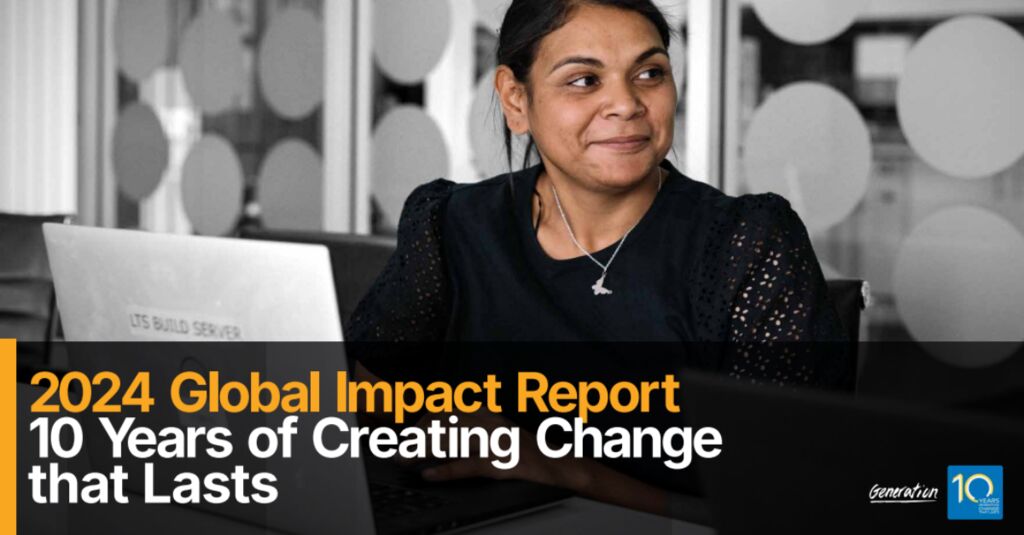Beyond Age: The Value of Employing Older Workers

AI in the Workplace: Preparing Your Team (and Your Culture) for the Next Shift Prepare your team for AI-driven change—adapt culture, upskill employees, and embrace innovation for future-ready organizations.
Read it now
The paradox of aging is clearer than ever. Older people are healthier and more educated than prior generations, yet ageism persists across the globe. Outdated views of old age linked to diminished ability to function effectively have fueled biases that exclude older adults from fully participating in the economy and society. As a result, rising numbers of older workers face unemployment today–amid global talent shortages projected to lead to more than 85 million vacant jobs by 2030 that would result in annual revenue losses of nearly $8.5 trillion.
To better understand the challenges and opportunities for midcareer workers, Generation, a global nonprofit network that supports people to achieve economic mobility and a better life, partnered with the OECD with support from Google.org to develop the first of its kind research on this burgeoning demographic. According to our global survey that spanned eight countries across the US, UK, and Europe, individuals aged 45-60 make up the bulk of the long-term unemployed in many countries, and they face growing barriers to finding good jobs. In South Korea, for example, the old-age poverty rate has surpassed 40%. It is over 30% in Estonia and Latvia, and more than 20% in Mexico and the US.
This insight into the challenges faced by older workers highlights the critical need for focused interventions. Building on Generation’s initial work with younger people, we have expanded our efforts to support midcareer workers who are facing job loss due to digitization and automation. Our goal is to replicate the impact we’ve had with younger people for midcareer and older workers. 79 percent of employers repeat hiring from Generation, 94 percent say that graduates perform at a similar or higher level than their peers, and employed graduates immediately earn an average of 3-4X their previous earnings.
Critical to our mission of going beyond these numbers and “reaching 500,000 graduates by 2030 is unlocking opportunities for midcareer and older workers,” says Mona Mourshed, Global Generation CEO. “For the world to not be able to take advantage of the productivity and expertise of this population is tragic —let alone what it means for their own personal lives— if they’re unable to have opportunity and financial independence.”
Below are outcomes poised to come from greater investments in and appropriate interventions for this cohort.
Enhanced workforce productivity
Companies with age-diverse teams report their value, largely attributing it to bringing together people with complementary abilities, skills, information, and networks. Research from the OECD further supports this, showing that intergenerational teams have lower turnover and higher productivity rates than their benchmark peers.
Generation’s Midcareer Opportunity report underscores that employers who do hire older workers say that they consistently match or exceed the performance of younger hires. Our research has surfaced what we call “the age-performance paradox,” or the gap between what employers say about older workers and what they actually experience. Despite pervasive reluctance to give interviews to candidates over the age of 45, 89 percent of employers reported that the midcareer and older workers they had hired performed as well or better than their younger hires.
Knowledge transfer
Older workers bring vast knowledge and diverse perspectives that can help build organizational resilience. Even if they’ve worked in another industry for a portion of their career, the perspective older workers have gained over time can help them see the bigger picture more clearly and contribute to their teams. For example, the rise of remote work since the COVID-19 pandemic and rapid technological advancements have limited younger workers’ exposure to soft skills like in-person communication and conflict management. In a business climate that can change overnight, older workers can offer lessons learned from their previous experience to help organizations navigate changing times.
A more stable labor market
Midcareer and older workers are ready to seek out more satisfying roles. Hiring them could improve the supply of talent and help restore balance to labor markets that are still recovering from the COVID-19 pandemic. In 2022, OECD countries had a 50 percent increase in vacancies per unemployed person since 2019. According to McKinsey research, when evaluating the economic implications of enabling older workers to remain in the workforce, there is the potential for an almost $6.2 trillion opportunity in annual GDP across over 20 countries surveyed.
Related to this topic:
AI in the Workplace: Preparing Your Team (and Your Culture) for the Next Shift
Societal benefits
Providing access to better labor market opportunities for midcareer and older workers would mean less burden on younger workers to support a growing number of pensioners. Lower economic dependency ratios would guarantee less fiscal pressure and make it easier to maintain current levels of public welfare and retirement spending. Unless productivity growth increases by two to four times or people work one to five hours more per week, GDP per capita growth could slow by 0.8 percent annually on average through 2050.
The reality of today’s longer life expectancy, coupled with fewer younger workers to help finance the retirement system, increases the likelihood that more individuals will continue working past the traditional retirement age. To stabilize the old-age dependence ratio by 2050 would require up to an 8.4-year increase in the retirement age, a figure that is not a feasible expectation. To manage this transition, there are key actions stakeholders can take now.
- Invest in training programs
Employers value degrees and certifications, but merely offering them to older employees is not enough. Training participation decreases with age, across all education levels, with Generation research showing only 38% of surveyed individuals over age 45 had participated in training in the past year. Removing friction, like cost or time, and introducing incentives can make the hesitant much more willing to participate. This could look like free training coupled with a job guarantee, or at least a job interview guarantee, along with stipends to cover living expenses.
- Include AI in upskilling
It is important to not assume that because many older workers don’t currently use AI means they can’t. The reality is that it is not obvious to experienced workers how AI can fit into their work. According to a 2021 AARP survey, 94% of older workers are interested in additional job skills and training with employer support.
This gap points to a need for employers to find use cases that incorporate AI into specific roles and experience levels. One starting point would be to identify midcareer and older workers who are already using AI tools and successfully integrating them into their daily job tasks. Generation research shows that more than half of midcareer and older workers in the US and two-thirds in Europe who are using AI regularly reported that it is improving their work quality and pace. By recognizing and incentivizing these employees to share their knowledge and mentor their peers, employers can both empower experienced workers and drive measurable productivity improvements.
- Change hiring practices
Generation research shows that while most of the 45+ individuals perform as well, if not better than, their younger peers in the interview process, the biggest hurdle is getting past the initial screening for an interview. One solution could be a shift from a traditional CV-centered interview process to one that is more demonstration-based where 45+ candidates can perform the job task.
Generation applies such demonstration-based interviews in our own programming—whether that is sharing the graduates’ portfolios or having them perform the job task in some way. Another tactic we employ to make it easier for recruiters to find the talent they need from Generation graduates is a custom-built employer portal. Developed with support from Google.org Fellows, the portal allows employers to search for talent based on the skill-set of job seekers already validated by Generation, rather than demographic information like age, gender, or education.
- Employ flexible working practices
A successful age-diverse workplace will be one that can accommodate the needs of its workers – including around when and where they work and for how much of the week. According to the OECD, workers increasingly value flexibility as they age, and older workers are more likely to work for longer if their jobs are more flexible. Research by the National Bureau of Economic Research in the US shows that flexible work hours had the largest effect on whether people worked after the age of 70.
The evidence is clear: the future of work is intergenerational, and embracing older workers is not just an act of social equity but also a strategic advantage. No single organization can solve unemployment alone. Generation brings together a diverse set of partners—employers, government, training providers, and funders. It is together where we can change lives.



